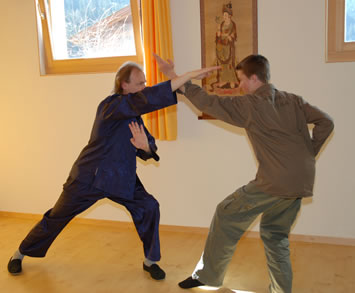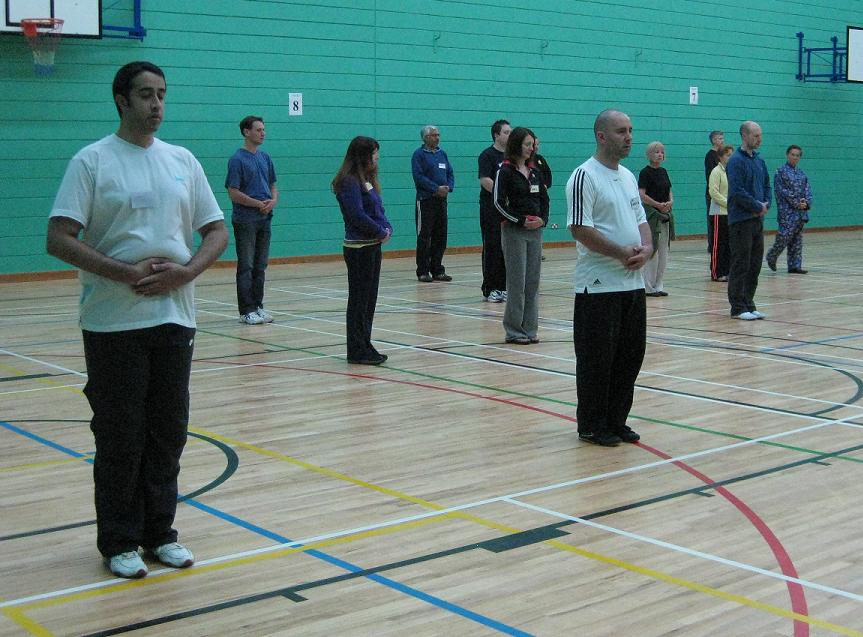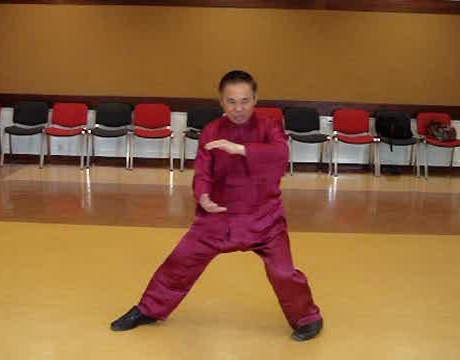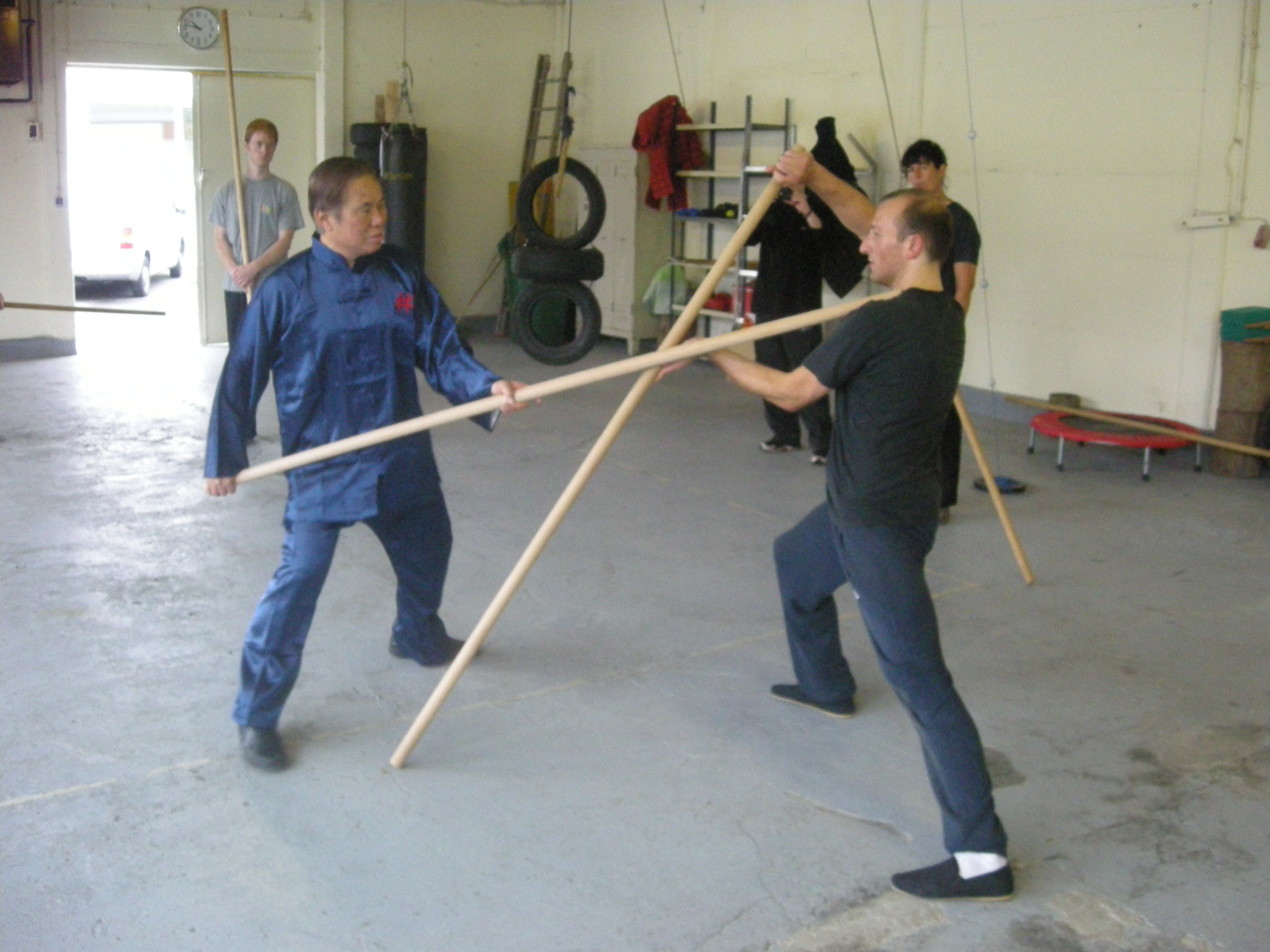SELECTION OF QUESTIONS AND ANSWERS
JUNE 2016 PART 3

It is ridiculous that some kungfu masters explicitly say that kungfu cannot be used for combat
Question 1
I am a great fan of the Chinese Martial Arts and particularly of your English books explaining them. I have purchased and read "The Complete Book of Shaolin Kung Fu", "The Complete Book of Tai Chi Chuan", "The Complete Book of Chinese Medicine" and most recently, "The Art of Chi Kung." Thank you so much for your deep understanding of the Chinese and English languages and your skill and explaining the beauty of the arts.
— Nicky, USA
Answer
Thank you for your kind words.
Chinese martial arts have been so debased that most practitioners today, including some masters, cannot apply them for martial purposes. They perform genuine kungfu forms for demonstration, which is known in Chinese as "flowery fists and embroidery kicks", or use techniques from other types of martial arts, especially from Boxing and Kick-Boxing, in a generous exchange of blows and kicks without any self-defence.
Chi kung has been so debased that it has become gentle physical exercise, and not energy art, which it actually is, and which the term "chi kung" actually means. Most practitioners today, including some masters, have no experience of chi, or energy, and have no chi kung benefits like good health and vitality. It is indeed shocking that many chi kung practitioners today, despite having practiced chi kung for many years, are still in pain or sickness.
Obviously, if you want to benefit from Chinese martial arts or chi kung to enrich your daily life, you must learn from genuine masters or at least competent teachers. But such masters and teachers are very rare today, a fact that many people may not realize.
Question 2
I have a question regarding Qigong. I do not have a teacher. I have been attempting to teach myself based on your descriptions in the books.
Answer
While we can have reading pleasure and useful information from good books, their greatest beauty lies in enabling readers to enrich their daily life. This is particularly important and meaningful in subjects like chi kung and Chinese martial arts, because chi kung and Chinese martial arts have been much debased, and there is much misinformation about them.
Although your intention is good, it is not advisable to teach yourself chi kung, spelt as qigong in Romanized Chinese. At best you perform gentle physical exercise which you mistake as chi kung, or energy art. This in fact is the situation of more than 80% of chi kung practitioners in the world today. Worse, you may harm yourself.
These situations, i.e. practicing gentle physical exercise and harming yourself, occur because the crucial factor in chi kung practice is skills, not techniques. You can learn techniques correctly and even beautifully from books, but you need to learn skills from competent teachers.
It is like swimming and driving. You can learn swimming and driving techniques from books, but you need to learn the skills to swim or to drive from competent teachers. Even when you know the techniques correctly but do not have the skills, you cannot swim or drive, and if you attempt to do so you may harm yourself.

Abdominal Breathing is an advanced art and should be learnt from a master
Question 3
I have been practicing Abdominal Breathing. I've developed a slight pain just under my sternum. Have you heard of this happening? Please let me know what you might recommend.
Answer
Yes, I have come across many cases like yours.
It is easy to make mistakes in advanced chi kung exercises like Abdominal Breathing. Abdominal Breathing looks simple, but is difficult to be performed correctly -- another fact that not many people may know. If an exercise has 10 techniques, and a practitioner makes a mistake, he is 10% wrong. If an exercise has only 1 technique, and he makes a mistake, he is 100% wrong.
Advanced exercises usually have few techniques, and often only one technique. This is another fact that many people may not know. Advanced exercises also require more skills to be performed well.
Many people have the misconception that the more advanced an exercise is, the more techniques it has. It is the reverse. As an analogy, a salesman who uses only one technique to conclude a sale is more advanced than another salesman who uses ten. The advanced salesman is also more skillful. Like salesmen, advanced exercises have gone through periods where unnecessary techniques have been removed resulting in few techniques.
You have practiced Abdominal Breathing incorrectly, resulting in pain, which is a signal telling you of wrong practice. Your slight injury does not look serious, and if you stop your wrong practice it may go away by itself.
A surer and safer way is to perform some remedial exercise. The best remedial exercise is Self-Manifested Chi Movement, but this type of chi kung exercise, though very safe and actually simple, is difficult to be accomplished by those learning on their own or even those learning from living instructors.
An easier and effective way is to perform Lifting the Sky. You can learn it from my books.
It is best if you learn from a competent living instructor, who will not only help you to overcome your injury from wrong practice but also enable you to enjoy many chi kung benefits. If you wish to learn from us, please see our List of Instructors. If you wish to learn from me, please see my time-table on my home page.
Question 4
When we turn around to the other side when practicing Grasping Sparrow's Tail, we can use our heels or our toes as pivots. What is the difference?
— Brendan, Ireland
Answer
Relatively, when we use our heels, we are more solid. When we use our toes, we are more agile. This is relative. We can also be agile when we use our heels, and solid when we use our toes.

Grasping Sparrow's Tail
Question 5
Does this means that if a strong, powerful opponent pushes at us, we use our toes?
Answer
Not necessarily. It depends on the combat situation. If we do not want to move away but use our "shen-fa" or body-movement to neutralize his force, we don't have to use our heels or toes to turn. We sink down and back in our stance to let him fall forward, and counter attack him.
If we want to turn around and push him to our hack, we can use our heels for solidity as we turn. But if we want to move to a side and push him away from the side, we can use our toes.
In practical situations, we don't have to worry whether we use our toes or heels as pivots when we turn or move. We just turn or move spontaneously. The use of the heels or toes for turning or moving is a philosophical topic, and is useful in our training.
Question 6
I'm trying to inquire some information on the Shuang Shou Jian. There seems to be little information. Would you mind shedding some light on this style?
— Nareshwar, India
Answer
There is not much information on the shuang sou jian, or double swords, where an exponent holds two swords, one in each hand, because they were not a popular weapon. One sword would interfere with the other sword. The exponent would be more adroit if he held only one sword, and adroitness was a paramount feature of swordsmanship.
The double sabres were also not a popular weapon for the same reason that one sabre might get in the way of the other. But it was more so with the double swords. While adroitness is a paramount feature of the sword, that of the sabre is ferocity.
The double swords were more popular in sword dances than in combat. Nevertheless, Liu Bei, the King of Shu during the Three-Kingdom Period of China in the 3rd century CE, used the double swords. But Liu Bei was not a formidable warrior, he was more known as a caring ruler.

Grandmaster Wong using a staff to apply dim mak on an opponent
Question 7
In employing Single Whip for fa-jing, do we use the centre of the palm or the side of the palm for striking?
— Sifu Kevin Barry, Ireland
Answer
When we train fa-jing, or exploding force, using Single Whip, we use the edge of our palm.
We also use the edge of the palm in combat application when applying Single Whip. But in actual combat, it really does not matter whether we use the centre or the edge of the palm. We just use Single Whip spontaneously to strike.
Single Whip is an effective technique to train fa-jing. When we have developed internal force, not only we can explode force using the edge of the palm, we can also explode force with the centre of the palm or any part of the hand or any part of our body using any pattern, though it may be more difficult to explode force with certain parts of the body, like the shoulder or the hip.
We can explode force not just in attack but also in defence. For example, when an opponent attacks you with a thrust punch, you can explode force when warding off his attack using Immortal Waves Sleeves, and you may break his arm.
Question 8
I was very surprised that we could use a staff for dim mak. Are there other weapons that can also be used for dim mak? Which is easier for a dim make master, using a weapon or just using his finger?
— Dominic, Ireland
Answer
Not many kungfu practitioners know that weapons can be used for dim mak. In fact many kungfu practitioners, including some masters, don't believe that dim mak is true. Some think that it was true in the past, but now the art has been lost.
There is no doubt that dim mak is true. Not only my sifu, Sifu Ho Fatt Nam, could do it, I could do it, and some of our senior instructors could do it, almost all those who attended my Special Dragon Strength Course in Penang in December 2014 did it.
Kevein (Sifu Kevin Barry of Ireland) had a memorable experience. Damian gave a feint move above, then struck Kevin's upper leg below at the zhusanli vital point. Kevin was dazed, wobbled backward a few steps against a wall, then collapsed. Damian told me that at first he thought Kevin was joking. But seeing that Kevin was unconscious, he quickly gave Kevin remedial exercise, which not only cleared the dim mak injury but also other blockages that Kevin had earlier. To be double sure, I also treated Kevin the next day.
I am very glad that I taught dim mak, an almost lost art, at the Special Dragon Strength Course. It was a big class, in two courses, with about a hundred course participants. I did not mention about dim mak earlier as I meant it to be a surprised present for the course participants. It was simply incredible that the course participants learned dim mak in just five days, including developing the necessary internal force, the techniques in applying dim mak, and the remedial exercise needed to take away the dim mak injury, besides learning other aspects of the amazing Dragon Strength Set.
Besides using the finger, dim mak can also be applied using some weapons. The staff can be used for dim make with the pattern, "Phoenix Dots Head". Two other weapons that are suitable for dim mak are the handy fan and the umbrella.
It is easier to use a finger than a weapon for dim mak. A master has to channel his internal force for dim mak and it is easier to do so with his own finger than with a weapon.
LINKS
Selected Reading
- The Ultimate Technique
- The Flowing Characteristics of Taijiquan
- Wu Yu Xiang Taijiquan
- From the Humble to the Majestic
